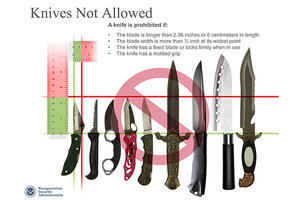TSA relents, re-bans knives on airplanes. More pressure coming?
Aviation workers chalk up a victory in a spat with the TSA over whether to let passengers carry small knives, such as pocketknives, on board airplanes. Signs are that they want TSA to make even more safety-related changes.

This undated image shows a page from a TSA pamphlet of Changes to Prohibited Items List (PIL), of the sizes of knife blades not allowed on airplanes.
Courtesy of TSA/AP
Pocketknives of any shape and size are back on "banned" list of items air passengers may not carry into the cabins of commercial planes – a victory for aviation workers who had pressured the Transportation Security Administration (TSA) to rethink its decision of three months ago to stop confiscating such knives during passenger screening.
But the workers, which included pilots, flight attendants, and air marshals, do not intend to chalk up the victory and fly off into the sunset. Rather, a flight attendants union is pressing for a federal law that would keep knives off airplanes for good, and others are urging the TSA to beef up security out on the tarmac, where a host of service workers have access to the planes themselves.
The knife episode appeared to drive a wedge between aviation workers and the TSA – one that does not seem to be fully removed despite the TSA announcement Wednesday revoking the original decision in March to lift the knife ban. Groups that represent the industry's workers continued this week to suggest to TSA other safety moves it should make.
The TSA's original move was intended to allow those who screen passengers and carry-ons to focus intently on searching for threats the agency deems to be more dangerous, such as explosives. Hence, it said it would no longer prohibit certain carry-on items on planes, including golf clubs, ski poles, pool or lacrosse sticks, and novelty baseball bats. The list included knives no longer than 2.36 inches in length or a half-inch in width, or ones that do not have molded grips or fixed blades. The description fits most pocketknives.
The TSA reversed the knife decision “after extensive engagement” with law enforcement officials, advocates of passengers, the Aviation Security Advisory Committee, “and other important stakeholders,” the agency said in a written statement. On Thursday, the TSA promised it would “continue to keep passengers safe by focusing on those [risks] we know less about” and “will continue to take steps to improve our ever evolving security posture while also improving the experience of the traveling public.”
The Washington-based Association of Flight Attendants, a union that backs current House and Senate legislation to permanently ban knives on airplanes, applauded the TSA decision. “The outcome of [the TSA action] means passengers and crew are safer today … this is a bipartisan issue that is supported by the vast majority of Americans. It’s about our security and it’s time,” the group said in a statement released Wednesday.
Some have questioned the reliability of the TSA screening system. In confiscating hundreds of thousands of items, screeners tend to focus on things that are not necessarily banned, or on people who are not obvious threats, but largely miss weapons that are deliberately concealed by safety-testing personnel, they say. The Airline Pilots Security Alliance, an advocacy group based in Boston, claims that data suggest that current screening techniques and technology would be reliable less than 5 percent of the time in preventing terrorism.
Joseph LaSorsa, a security consultant and former US Secret Service agent now based in Miami, supports the TSA decision to re-ban knives, but says the agency needs to fortify its efforts to screen people who are allowed to interact with aircraft before flight.
“As long as they are diligently screening passengers, we are fairly safe onboard a flight. But that’s not where we are really vulnerable,” Mr. LaSorsa says. “The exposure to airlines and airline travel is on the tarmac."

